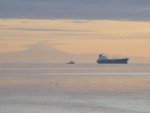MaxDad":3is1o3od said:
Actually the radar is the big part of my thinking but I also found a vender of a new icon m506 vhf. It receives ais so I can get half way there. Thanks for taking the time for all the replies so far…
MaxDad, You hit the nail on the head. Yes, Radar (Use as described above, use it and keep it on so you can understand what you see on the screen and how it relates to what is around you.
Also, cheap and easy, a radar reflector. The 10 inch round disc increased your radar return by about 50%.
The ICOM, M-506 is my favorite VHF for having multiple plusses. The last call, 2 minute record feature, (which I have used several times as an advantage to situational awareness), the AIS receive, the hailer/auto fog horn and all that with a very easy, user friendly menu function. With the NEMA 2K you sill be able to put the AIS targets onto your Garmin screen and that makes life way easier. (BTW, the M-506 also has the largest screen IF you are going to use that screen for monitoring AIS targets.)
Tom is right, the radar will pick up the closets hazards to you, and they can be immediate threats, BUT, the AIS will pick up the biggest targets, and they an cover a fair distance very quickly, and can be equally or more so, deadly. AIS and Radar are the winning hand.
Harvey
SleepyC :moon




